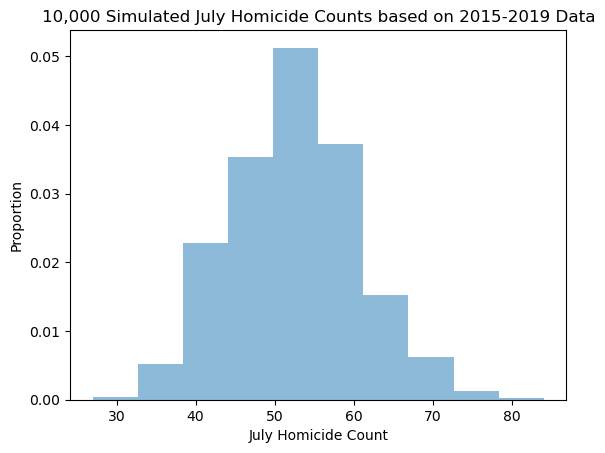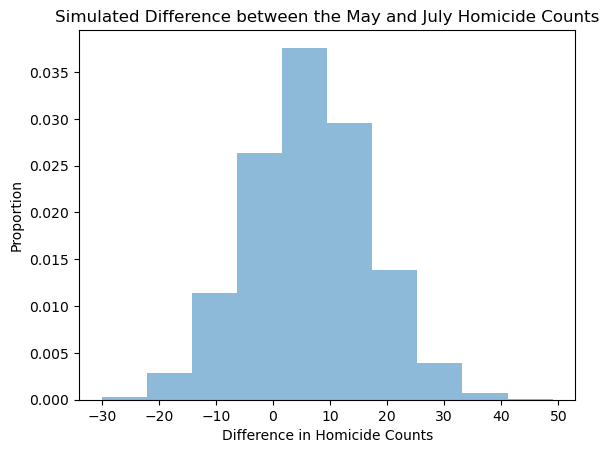Show code cell source
import pandas as pd
import numpy as np
import random
5.11. JNB Lab Solutions#
Exercise 1a
Read in Homicide data and drop rows that have missing data.
Show code cell source
Hom=pd.read_excel('homicides.xlsx') #read data file
Hom=Hom[Hom["Manner of Death"]=='HOMICIDE']
Hom=Hom[["Date of Incident","Age","Gender","Race","Primary Cause","Residence City","Incident Zip Code"]]
Hom=Hom.dropna()
Hom.head(1)
| Date of Incident | Age | Gender | Race | Primary Cause | Residence City | Incident Zip Code | |
|---|---|---|---|---|---|---|---|
| 0 | 2017-02-26 10:48:00 | 23.0 | Male | Black | MULTIPLE GUNSHOT WOUNDS | Chicago | 60623.0 |
Extract the month and year of homicide incidents.
Show code cell source
from datetime import datetime
Hom['new_date'] = [d.date() for d in Hom['Date of Incident']]
dates=Hom['new_date'].values
year=[my_str.year for my_str in dates]
month=[my_str.month for my_str in dates]
day=[my_str.day for my_str in dates]
Hom['year'] = year
Hom['month'] = month
Hom['day'] = day
Hom.head(1)
| Date of Incident | Age | Gender | Race | Primary Cause | Residence City | Incident Zip Code | new_date | year | month | day | |
|---|---|---|---|---|---|---|---|---|---|---|---|
| 0 | 2017-02-26 10:48:00 | 23.0 | Male | Black | MULTIPLE GUNSHOT WOUNDS | Chicago | 60623.0 | 2017-02-26 | 2017 | 2 | 26 |
Get Chicago data, select the columns [“Age”,“Gender”,“Race”,“Primary Cause”,“Incident Zip Code”,“year”,“month”,“day”] and use integer format
Show code cell source
ChiHom=Hom[Hom["Residence City"]=='Chicago'] #get data for just Chicago
df=ChiHom[["Age","Gender","Race","Primary Cause","Incident Zip Code","year","month","day"]]
df=df.dropna()
df['year']=df['year'].astype(int)
df['month']=df['month'].astype(int)
df['day']=df['day'].astype(int)
df['Age']=df['Age'].astype(int)
df['Incident Zip Code']=df['Incident Zip Code'].astype(int)
df=df[df["year"]>2014]
df.head(1)
| Age | Gender | Race | Primary Cause | Incident Zip Code | year | month | day | |
|---|---|---|---|---|---|---|---|---|
| 0 | 23 | Male | Black | MULTIPLE GUNSHOT WOUNDS | 60623 | 2017 | 2 | 26 |
Get the number of Chicago homicides in July 2020.
Show code cell source
july=df[df["month"]==7]
july20=july[july["year"]==2020]
print("Chicago Homicides In July 2020: ",len(july20))
Chicago Homicides In July 2020: 89
Get the number of homicides which occurred on each day of July between 2015 and 2019.
Show code cell source
julydf=july
julydf=julydf.reset_index(drop=True)
julycount=pd.Series(np.arange(0,155,1))
julycount[:]=0
j=0
for year in np.arange(2015,2020,1):
for day in np.arange(1,32,1):
for i in julydf.index:
if julydf.loc[i,"day"]==day and julydf.loc[i,"year"]==year:
julycount[j]=julycount[j]+1
j=j+1
print(julycount[0:5])
0 0
1 1
2 3
3 1
4 4
dtype: int32
Get frequency distributions for the number of homicides in a day
Show code cell source
jm=julycount.max()
julyfreq=pd.Series(np.arange(0,jm+1,1)) #create a series with index the number of homicides and value equal to the frequency
julyfreq[:]=0
dj=julycount
for i in julycount.index:
for j in np.arange(0,jm+1,1):
if dj[i]==j:
julyfreq[j]=julyfreq[j]+1
s=julyfreq.sum()
julyfreq=julyfreq/s
print(julyfreq)
julyfreq[0]
0 0.200000
1 0.309677
2 0.258065
3 0.141935
4 0.051613
5 0.012903
6 0.012903
7 0.012903
dtype: float64
0.2
Do a Monte Carlo simulation for monthly homicide counts in July based on 31 random draws from the respective empirical distributions.
Show code cell source
n = random.random()
nummonths=10000
numdays=31*nummonths
julydaytotal=pd.Series(np.arange(0,numdays,1))
julydaytotal[:]=0
for i in np.arange(0,numdays,1):
x=random.random()
exit=0
cum=0
for j in julyfreq.index:
if x< cum+julyfreq[j] and exit==0:
julydaytotal[i]=j
exit=1
else:
cum=cum+julyfreq[j]
julymonths=pd.Series(np.arange(0,nummonths,1))
julymonths[:]=0
i=0
for month in np.arange(0,nummonths,1):
sum=0
for j in np.arange(0,31,1):
sum=sum+julydaytotal[i]
i=i+1
julymonths[month]=sum
month=month+1
Make a histogram for July.
Show code cell source
import matplotlib.pyplot as plt
#Make Histogram
fig, ax = plt.subplots()
n,bins,patches = ax.hist(julymonths, bins=10,density=1,alpha=.5)
plt.xlabel("July Homicide Count")
plt.ylabel("Proportion")
plt.title("10,000 Simulated July Homicide Counts based on 2015-2019 Data")
Text(0.5, 1.0, '10,000 Simulated July Homicide Counts based on 2015-2019 Data')

Exercise 1b
b) Find the empirical p-value of getting at least 108 homicides (the number in July 2020.)
Show code cell source
julycount=julymonths[julymonths>=108]
pjuly=len(julycount)/10000
print("Probaility that a random draw of 31 days from July 2015-2020 distibution results in 85 or more homicides:",pjuly)
Probaility that a random draw of 31 days from July 2015-2020 distibution results in 85 or more homicides: 0.0
Exercise 2
a) Make a histogram of the difference July homicide count - May homicide count
Show code cell source
maydf=df[df["month"]==5]
maydf=maydf.reset_index(drop=True)
maycount=pd.Series(np.arange(0,155,1))
maycount[:]=0
j=0
for year in np.arange(2015,2020,1):
for day in np.arange(1,32,1):
for i in maydf.index:
if maydf.loc[i,"day"]==day and maydf.loc[i,"year"]==year:
maycount[j]=maycount[j]+1
j=j+1
mm=maycount.max()
mayfreq=pd.Series(np.arange(0,mm+1,1)) #create a series with index the number of homicides and value equal to the frequency
mayfreq[:]=0
dm=maycount
for i in maycount.index:
for j in np.arange(0,mm+1,1):
if dm[i]==j:
mayfreq[j]=mayfreq[j]+1
s=mayfreq.sum()
mayfreq=mayfreq/s
n = random.random()
nummonths=10000
numdays=31*nummonths
maydaytotal=pd.Series(np.arange(0,numdays,1))
maydaytotal[:]=0
for i in np.arange(0,numdays,1):
x=random.random()
exit=0
cum=0
for j in mayfreq.index:
if x< cum+mayfreq[j] and exit==0:
maydaytotal[i]=j
exit=1
else:
cum=cum+mayfreq[j]
maymonths=pd.Series(np.arange(0,nummonths,1))
maymonths[:]=0
i=0
for month in np.arange(0,nummonths,1):
sum=0
for j in np.arange(0,31,1):
sum=sum+maydaytotal[i]
i=i+1
maymonths[month]=sum
month=month+1
Show code cell source
diff=julymonths-maymonths
import matplotlib.pyplot as plt
#Make Histogram
fig, ax = plt.subplots()
n,bins,patches = ax.hist(diff, bins=10,density=1,alpha=.5)
plt.xlabel("Difference in Homicide Counts")
plt.ylabel("Proportion")
plt.title("Simulated Difference between the May and July Homicide Counts")
plt.savefig("Diff.png")

Find the probability that July will have at least n more homicides than May \((0\le n \le 20)\).
Show code cell source
pdiff=pd.Series(np.arange(0,21,1))
for i in pdiff.index:
pdiff.loc[i]=len(diff[diff>=i])/10000
pdiff
0 0.7409
1 0.7091
2 0.6766
3 0.6436
4 0.6077
5 0.5694
6 0.5298
7 0.4885
8 0.4529
9 0.4168
10 0.3796
11 0.3436
12 0.3082
13 0.2773
14 0.2459
15 0.2171
16 0.1889
17 0.1677
18 0.1461
19 0.1246
20 0.1045
dtype: float64
b) Make a plot of these probabilities
Show code cell source
%matplotlib notebook
import matplotlib as mpl
import matplotlib.pyplot as plt
plt.plot(pdiff, 'o-',color='k')
for i in pdiff.index:
plt.text(i,pdiff[i]+.01, str(pdiff[i]),color='r',size=6)
plt.text(i-.2,pdiff[i]-.03, str(i),color='k',size=6)
plt.xlabel("Number More Homicides in July than in May")
plt.ylabel("Estimated Probability Based on 2015-2019 Data")
xl = np.arange(21)
plt.xticks(xl, xl, alpha=0.7,size=5)
plt.title("Probability that Chicago's July Homicide Count Exceeds May Homicide Count",size=8)
plt.savefig("MayvsJuly.png")
c) Based on 2015-2019 data, there is a 10% chance of 20 more homicides in July than May.

